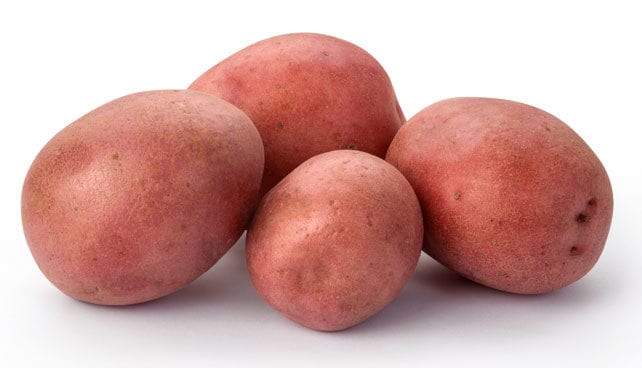 Best for: Baking, Frying, Mashing, Roasted
Best for: Baking, Frying, Mashing, RoastedAvailable: Year-round
More about Russets
Wisconsin potato growers offer a wide selection of quality potato varieties — Russet, White, Red, Yellow, Fingerling, and Blue and Purple potato varieties. Our state-of-the-art seed potato farm in Rhinelander, Wisconsin, employs the potato industry’s top researchers who test and develop tomorrow’s potato varieties. And our continuing partnership with University of Wisconsin researchers contributes to our position as a global leader in the development and production of potato varieties, as well as an eco-friendly potato brand — Healthy Grown®.
1
Appearance: medium to large, oblong or slightly flattened oval, light to medium russet-brown, netted skin, white to pale yellow flesh.
Texture: floury,dry; light and fluffy; hearty skin that is chewy when cooked.
Flavor: mild; earthy; medium sugar content
Russets are ideal for light and fluffy mashed potatoes. They also fry up crisp and golden brown, and they are the potato of choice for baking. The delicate flavor and fluffy texture of baked russets go well with all kinds of toppings, from traditional sour cream and chives to spicy and bold Mediterranean or Latin flavors.Try cutting into planks or wedges to make hearty oven-roasted “fries.”
Usage: With a low specific gravity (average 1.065), medium to high sugar content after storage at 45° F and strong flavor after storage, the Norkotah is great as an early direct delivery or stored for fresh market.
Tuber Appearance: Long and slightly flattened in appearance with medium russet skin and white flesh.
Usage: Fresh market potato with low to medium gravity that is great for baking, boiling, and processing.
Tuber Appearance: Oblong with russet skin and golden flesh.
Usage: Fresh and processing markets.
Tuber Appearance: Long russet with white flesh and medium specific gravity.
Usage: Direct delivery, stored for fresh market, or processing into french-fried or dehydrated product. Burbanks have a medium specific gravity and medium sugar content after storage at 45°.
Tuber Appearance: White fleshed potato with medium russet skin and long, slightly flattened appearance.
Usage: Full season availability for fresh market. Good boiling and baking quality.
Tuber Appearance: Blocky to long shape with light russet skin and white flesh.
Usage: Early direct delivery or stored for fresh market. Good for processing or dehydrated products, with medium specific gravity and medium sugar content after 45° F storage.
Tuber Appearance: Oblong with medium russet skin and white flesh.
Usage: Direct delivery or stored fresh market potato with high specific gravity and medium sugar content after storage at 45° F. Works well for processing, french-fried or dehydrated product.
Tuber Appearance: Long, slightly flattened potato with white flesh and medium russet skin.
Usage: Early direct delivery or stored for processing into french-fried product. Shepody potatoes have medium to low specific gravity (averaging 1.078) and high sugar content after storage at 45° F.
Tuber Appearance: This white-fleshed potato has buff or white skin and is long and flattened in appearance.
1
Appearance: small to medium; round to long shape; white or tan skin; white flesh
Texture: medium starch; slightly creamy, slightly dense; thin, delicate skin
Flavor: subtly sweet; mild; low sugar content
White potatoes hold their shape well after cooking. Their delicate, thin skins add just the right amount of texture to a velvety mashed potato dish without the need for peeling. Grilling whites brings out a more full-bodied flavor. Create signature potato salads–just toss cooked white potatoes with dressings and ingredients “borrowed” from other salads, e.g., Caesar dressing and grated Parmesan; or ranch dressing, chopped egg and bacon crumbles.
Usage: Chipping and fresh market, with medium to low specific gravity (averaging 1.073).
Tuber Appearance: Round, with white flesh and buff or white skin.
1
 Best for: Grilling, Roasting, Mashing, Salads
Best for: Grilling, Roasting, Mashing, SaladsAppearance: marble to large size; round or oblong shape; light tan to golden skin; yellow to golden flesh.
Texture: slightly waxy, velvety, moist
Flavor: subtly sweet; rich; buttery; medium-sugar content
Grilling gives yellow potatoes a crispy skin that enhances the dense flesh, creating a slightly sweet caramelized flavor. The creamy texture and golden color of yellow potatoes mean you can use less or no butter for lighter, healthier dishes. The naturally smooth and buttery texture also lends itself well to lighter versions of baked, roasted or mashed potatoes. Simmer yellow potatoes until fully cooked, then drain, chill, and gently “smash” into flat disks. Brown these in oil or clarified butter and serve as a side or appetizer topped with sour cream and chives or other garnishes.
1
 Best for: Roasting, Mashing, Salads, Soups/Stews
Best for: Roasting, Mashing, Salads, Soups/StewsAppearance: small to medium; round or slightly oblong; smooth, thin red skin; white flesh
Texture: waxy, moist and smooth; creamy
Flavor: Subtly sweet; mild medium sugar content
Because of their waxy texture, the flesh of red potatoes stays firm throughout the cooking process, whether they are being roasted or cooked in a stew. Their thin yet vibrant red skin adds appealing color and texture to side dishes and salads.Reds are frequently used to make tender yet firm potato salad or add pizazz to soups and stews, as well as being served baked or mashed. Round reds are often referred to as “new potatoes,” but the term “new” technically refers to any type of potato that is harvested before reaching maturity.
1
Appearance: small to medium-size; oblong to fingerling; deep purple, blue or slightly red skin; blue, purple lavender, pink or white flesh
Texture: moist; firm flesh. Note–all blue and purple Peruvian varieties have higher starch content and a floury texture
Flavor: earthy, nutty, low sugar content
Most blue/purple potatoes have moist, firm flesh that retains its shape while adding rich, vibrant color and luscious taste to salads. The purple color is preserved best by microwaving, but steaming and baking are also great ways to cook blue/purple potatoes. Because of their mild yet distinctly nutty flavor, blue/purple potatoes naturally complement green salad flavors. Red, White and Blues—Combine blue potatoes with whites and reds in salads or roasted medleys to make all three colors “pop”.
1
Appearance: 2-4 inches long; finger-shaped or oblong; red, orange, purple or white skin; red orange, purple, yellow or white flesh–sometimes streaked with veins of color.
Texture: waxy, firm, try
Flavor: buttery; nutty; earthy; medium sugar content
Fingerling color and shape are a welcome visual addition to any dish. Pan-frying and roasting enhance their robust flavor and showcase their wonderful nutty or buttery tastes.Consider fingerlings as a change-of-pace foundation for a unique potato salad. Split fingerlings lengthwise and oven-roast to serve as a small-plate or side-dish alternative to fries, with a flavor dipping sauce, like spicy ketchup, romesco, or sriracha mayo.